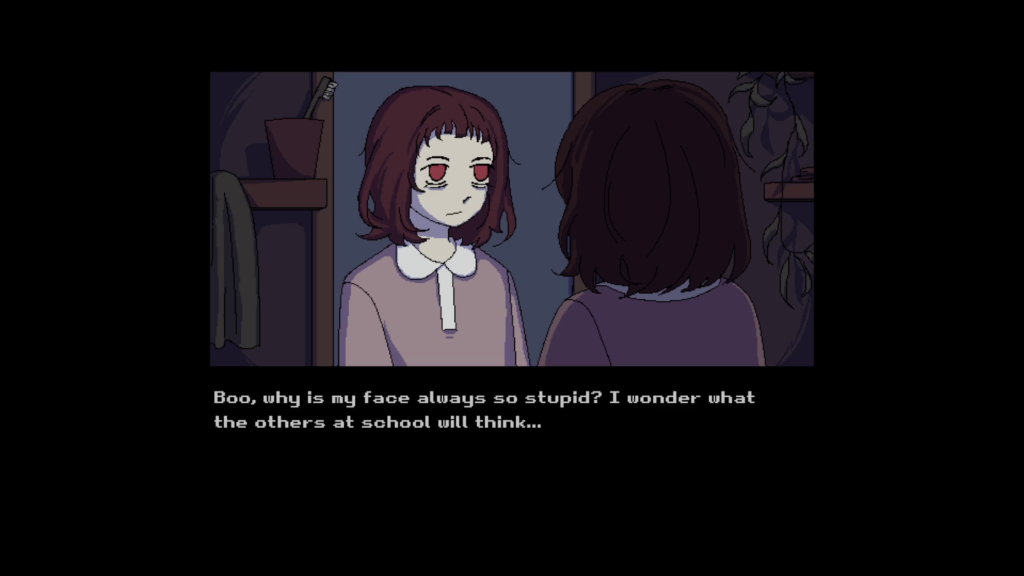Published 5 January 2022
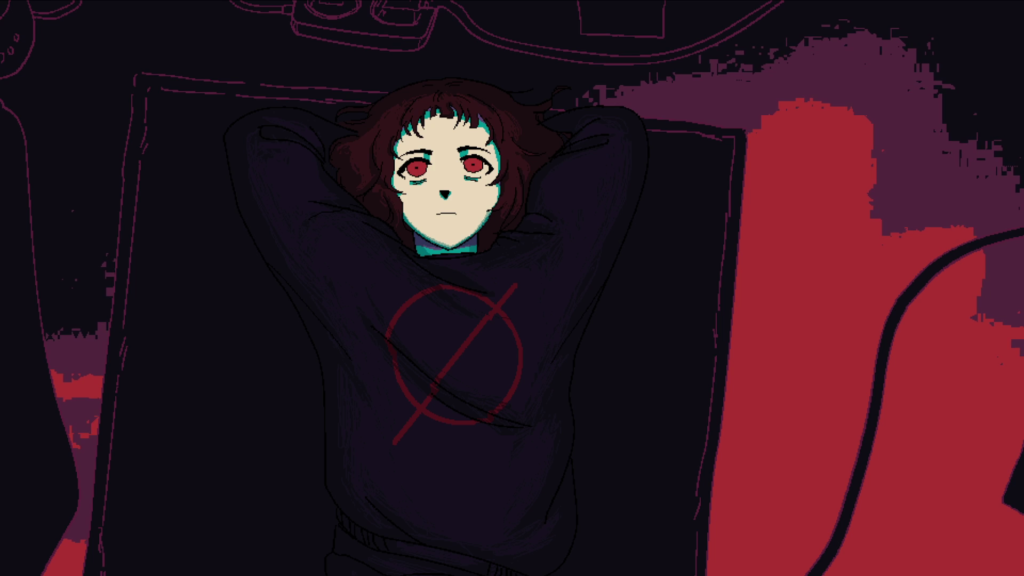
“I’m alone, but my head is full of thoughts. A whole world, one might say. If I try hard enough, it’ll be able to fill all the void around me! Still… No matter how much I keep thinking, my surroundings don’t change. Yes, something happened outside of my head, but… What was it? There’s not enough space for my thoughts. It’s already filled with something else… […] So the world isn’t empty, after all. I can’t see anything.”
Milk outside a bag of milk outside a bag of milk is a dark, surreal, and gorgeously illustrated video game from the end of 2021, available on Windows and Linux. The script was written by the project leader, Nikita Kryukov, and mahoumaiden, creator of REFLEXIA, a genre-deconstruction drama whose prototype released in 2022. The fourth video game from Kryukov, Milk outside begins almost immediately after the ending of the 2020 release Milk inside a bag of milk inside a bag of milk.
If such a recent title can be called a cult classic, Milk inside is a cult classic. This predecessor, “an artistic manipulation with word and form, only then – a game,” takes less than an hour to clear and, at full price, costs 1 USD, so, if you are interested, there is no reason not to try it. Both titles involve an unnamed girl suffering from psychosis and disorganized thinking who must carry out elementary pieces of daily life—in the first, going to the grocery store and, in the second, going to bed—and the player taking on the role of a somewhat belligerent voice in her head to hopefully steer her toward a happier outcome. Fans have taken to calling the girl (woman?) Milk-chan. No evidence suggests a Japanese setting, but she is drawn in an anime style. (And bears no relation to Super Milk-chan.)
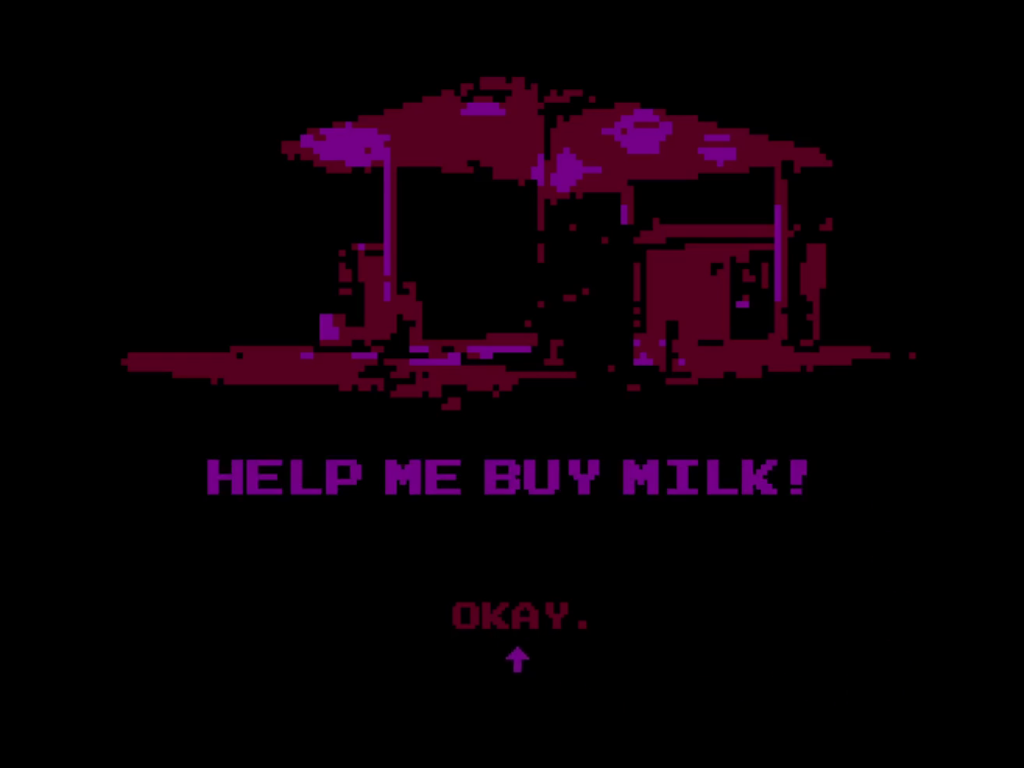
Milk inside and Milk outside are “visual novels.”* But neither tells a high-concept story with “lore” and “worldbuilding” or a big reveal that neatly solves everything like a puzzle. All of the literal events of Milk inside are portrayed in the Serial Experiments Lain-esque animated cutscene, created by Aleena Chrome, that opens Milk outside: the protagonist walks to a convenience store, buys a bag of milk, and walks back to her apartment, where her terrifying mother lets her inside. Oddly, this opening cutscene also depicts the unnamed protagonist picking up a box of milk instead of a bag, but for all I know, bags of milk are often sold inside boxes. Lain is an appropriate point of comparison given that it too stars a brown-haired young girl afflicted with an unspecified psychotic disorder who spends time staring at power lines. One of the pivotal events of Milk-chan’s life, the player might learn, even involves someone she met online.
*(I dislike the term “visual novel” because of the way it flattens the different varieties of Japanese adventure games. So far as I know, in Japan, “visual novel” was used as a marketing term for the Leaf Visual Novel Series, which are not even what most English speakers think of as visual novels, and never came to generically mean “video game with occasional choices, mostly static character sprites on mostly static backgrounds, and a text box at the bottom of the screen.”)

In ironic contrast to Milk-chan’s previous adventure, Milk outside takes place entirely indoors. An opening sequence depicts Milk-chan navigating her apartment, trying to escape hallucinations of shadow monsters, before her mother grabs her and seemingly injects her with some kind of drug and forces her to promise she will never drink milk again. Afterward, inside her room, after some conflict over taking her pills, Milk-chan’s thoughts transform into six fireflies that scatter around her stuff. Milk-chan is able to find one herself. In Milk inside, Milk-chan resolves her conflict by asking the player to treat her like a visual novel protagonist. This time she picks a different genre: “Now I want to become a point’n’click adventure game character!”
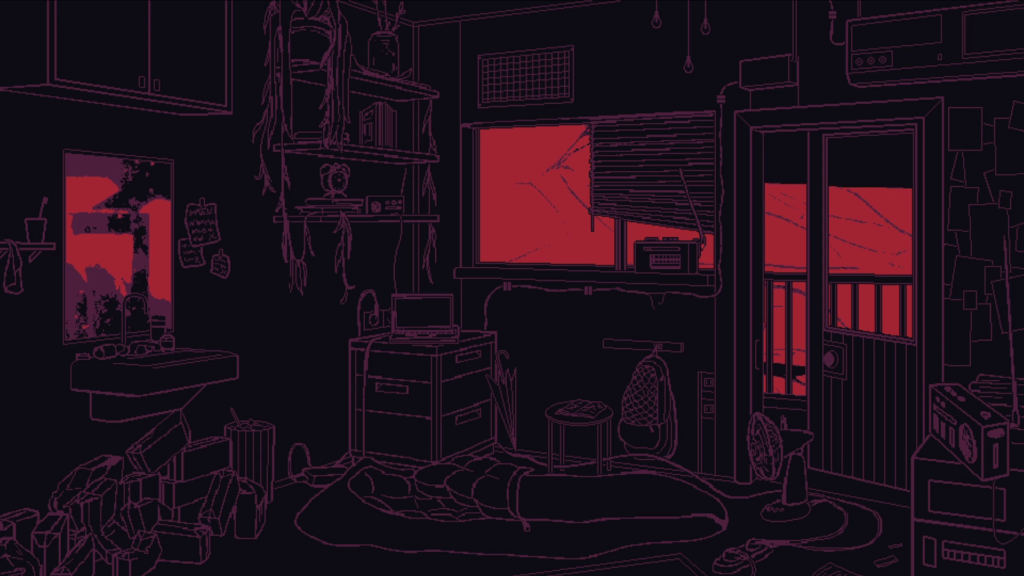
Clicking on different objects in the room, a shadowless line drawing yet immaculately realized, comprises the core gameplay. Each item elicits a unique conversation with Milk-chan. The player’s concrete goal is to find the five remaining fireflies. Depending on what the player clicks on and presses Milk-chan about, she will experience one of five possible dreams. The largest hurdle to seeing every dream is a choice that precedes the point-and-click section, which elicits a flashback of Milk-chan being attacked, locking the player into a specific dream. The dreams are the five different endings. Every dream triggers the same animated end cutscene and credit sequence, arguably giving the girl the happy ending she desires: to dream. But each dream distinguishes itself with contrasting tones, and, in a further display of visual excellence, a unique pixel art style that makes every one well worth seeing.
This gameplay also returns the “visual novel” to the point-and-click adventure games that spawned the format. The exploration of a single room to reach multiple possible outcomes, though limited in scope, also taps into a sense of freedom and of place largely absent in the simple route and abstract minimalistic graphics of Milk inside. As Milk outside lacks any lose state to discourage experimentation, it all results in a more dynamic experience. However, the constriction of the original is likely a deliberate choice. Milk outside feels less alienating and experimental, more “mainstream” than Milk inside. I wonder whether something has been lost.

Also making Milk outside more accessible is the most obvious change from its predecessor: far more detailed artwork and animations. In Milk inside the player could only glimpse Milk-chan in the ending or the game over screen, but now the player sees Milk-chan whenever she talks to us with her distorted digitized voice. The artwork remains eerie, and its color palette limited, in this case to red and black, with the exception of Milk-chan’s strikingly aquamarine skin. In another context, this might render her appearance corpselike. Here, however, the greenish blue is a soothing contrast to the colors of her environment, which connote blood and darkness rather than, say, anarcho-syndicalism. The contrast between this primary style and Milk-chan’s dreams displays a virtuosity of pixel illustration. The phone dream in particular seems like it comes from an entirely different video game. It is clear why Milk-chan wishes to dream of spaces, though most are nightmarish, so different from her own.
The “oppressive and viscous” soundtrack is, yes, oppressive, particularly the agonizing roars that blare from Milk-chan’s radios. “Thinking” reminds me of Silent Hill, a track like “White Noiz.” But the music can also be sublime, as in “concrete circle,” or almost Yume Nikki-like in tracks like “paper music” and “sleepy,” setting a tone of comfy, intimate darkness appropriate for standing beside a girl lying in her bed (or sleeping bag) opening up about her past. And sure, Milk-chan lives in a nightmare, but it’s her nightmare, you know? While Milk-chan has suicidal thoughts, she also does not entirely despise the reality in which her brain and trauma have trapped her:
“Sometimes I feel like the whole world pretends to be crazy. As if it’s trying to make me believe in something that doesn’t exist. […] At the same time… It makes me feel a little bit happy. Everything around me was created for my sake. To deceive, trick, confuse me… If that’s true, I guess I’m not so crazy myself, after all?”
And in an era where social narratives, already frequently false, have been poisoned by rampant misinformation and states, corporations, and political groups engage in international propaganda wars that increasingly lay ruin to any sense of shared reality, how delusional is Milk-chan’s belief that the world is out to deceive her? When I see her descend stairs under the power of some outside force in an expanse of concrete pillars, monolithic products of an inhuman industry as alien as Blame!, my thoughts tend more in this direction, toward the political machinations that have caused Milk-chan’s apartment building to gradually cover the horizon, than toward the more immediate interpersonal betrayals and abuse the writers probably intend.

If there is a flaw with Milk outside, it is the lack of an ability to skip through text the player has already read. The opening before the main gameplay—clicking around Milk-chan’s room—is several minutes long and, while gripping the first go, will be rather less on the sixth. Most visual novels incorporate a fast forward feature so that the player can see every ending without extensive rereading. I say “if there is a flaw” because this could well be a stylistic choice, Kryukov endeavoring to force the player to wallow in an ounce of the routine repetition that must grind Milk-chan down. (This could also well be me not figuring out which key skips text.)
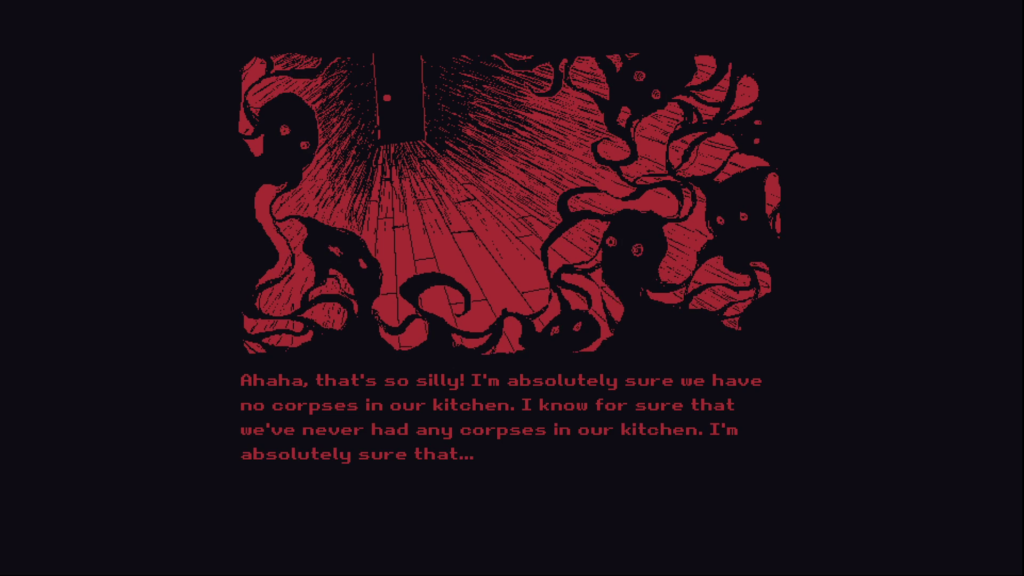
Then again, the itch.io page claims that Milk outside features a degree of randomization: “each playthrough is unique. However, some dialogue lines, images and scenes have only a small chance of appearing; you’ll have to really get close to the girl in order to find out everything she hides.” This promises “replay value” beyond the different endings. In my playthroughs, the only differences I noticed were different illustrations after the strangulation scene (the first seemed to portray someone gulping down a bag of milk) and different background images oozing behind Milk-chan and her furniture. True enough, then, that no two playthroughs were exactly alike. In my first, two giant eyes peered through her windows. But I wonder whether there are discrepancies more substantive than background graphics.
Especially given the bleak, paranoia-inducing surroundings of atomized modernity, in comparison with which the girl, in her vulnerability, is a breath of light and hope, it is difficult not to love unlucky Milk-chan. While assessing whether this depiction of (what seems to be) schizophrenia rings true to life is not my place, some reviewers on Steam, at least, strongly identify with Milk-chan’s experiences. Sympathetic portrayals of psychosis are certainly rare in media. Consider how the word “psychotic” itself connotes not severe mental illness but murderous frenzy. A compassionate eye cast on the subject always makes me glad and, in a well-made piece of digital art, even more so.
So yeah, Milk outside a bag of milk outside a bag of milk is a good use of nine dollars imo. You can buy it at Steam or itch.io.
